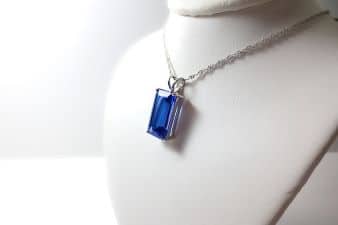All You Need To Know About Tanzanite Jewelry

Jewelry has the power to be the one little thing that makes you feel unique and special. Be it a special wedding occasion or simply a night out, they always add on to your looks.
Tanzanite has become one of the most popular gemstones used in jewelry for its unique color and natural beauty. With tanzanite jewelry, you can wear a piece that is as captivating as it is rare.
History of Tanzanite:

Tanzanite is a trading name given to gem-quality specimens of zoisite with blue color, which Tiffany and Company first used. They thought the “tanzanite” name would stimulate customer interest while being easier to market than its mineralogical namesake – “blue zoisites.” This comes from their belief that even if they sold it under “zohosites,” no one will know what that means because there are many different types of this type of material (i.e., nephrite jade). Since then, there have been various types of tanzanite pendants, pendants, and other jewelry.
Features of Tanzanite:
The tanzanite gemstone has a unique hue that can be described as a deep velvety blue with a purplish undertone, violet-red to reddish-orange tints, and variable brownish overtones. Tanzanite’sTanzanite’s beautiful blue color is a product of the vanadium-bearing zoisite. When heated to 600 degrees Celsius for about 30 minutes, the oxidation state of tanzanite changes – and that change brings out its natural beauty even more! Tanzanite is available as rough material for jewelry making, but rough tanzanite stones are not common, unlike ruby or sapphires.
Tanzanite is not only prone to scratches and fractures when worn but also during the setting process. The gem’s inherent division means that it could easily fracture if exposed to sudden changes in temperature or heated equipment like jewelry steam cleaners. Its cleavage makes Tanzanite vulnerable to fracturing should a jeweler clean with an abrasive material such as steel wool- so be careful! They can become damaged through wear or cleaning processes that require heat, chemicals, or pressure. It is difficult to cut Tanzanite due to internal fractures. Therefore Tanzanite is usually cut en cabochon (polished on the top only) or carved into elaborate shapes with faceting and sold as fancy diamonds. Check out some of the best tanzanite stud earrings here.
The range of colors that Tanzanite can come in is almost as wide and diverse as the color spectrum itself. Tanzanite’sTanzanite’s value ranges accordingly, too–the more saturated or vibrant its hue is, naturally, the pricier it will be! Tanzanites of all colors are becoming more widely available, but the ones with the best color usually command higher prices.
Tanzanite is like all other gems in that small stones are more abundant than larger stones. Most faceted tanzanites are under five carats in weight. Stones over fifty carats are very rare. Small stones are typically cut into calibrated sizes for use in commercial jewelry. Those with top-grade color are the most valuable and often go into a custom or designer jewelry. Large stones with exceptional color are usually reserved for tanzanite collectors who also become tanzanite investors. You can also check for some of the best shungite necklaces and shungite bracelets here.
Rarity of Tanzanite:
Tanzanites face a supply and demand situation depending on their color saturation. In recent years, the gemstone tanzanite price has risen dramatically along with other gems like rubies and sapphires because high-quality tanzanites are rare. When the prices for Tanzanite changed, it was not surprising that they experienced a sharp decline. Top-quality stones are usually more expensive and have less price instability than commercial grades of gems like Tanzanite, where competition is high. Many illegal miners entered into areas with easy to access mining in 2012 and 2013 when there would be plenty of customers ready to buy. This is during times when demand tended to go up due to their popularity as an engagement stone. It further drove those seeking them more even though supply went down sharply causing the prices for top quality workmanship pieces of jewelry made out of Tanzanites increase significantly.
Illegal mining has had its effects on Tanzanite. Currently, Tanzanite mined for tanzanite jewelry is around 40% gem quality tanzanites which have been illegally smuggled out of Tanzania to other countries such as India, Thailand, and China. They create Tanzanite jewelry without paying any taxes or import fees, they are then brought back into Tanzania where they pay a small fine before being sold again at top prices to the public.
Tanzanite is one of the best-selling colored stones in today’s gem and jewelry markets; at the same time, it is a rare gem of which there are few deposits. The currently known supply may be depleted in just decades, leaving many people out to buy the stone for themselves or their loved ones. The rarity and limited resource availability make Tanzanite an excellent choice for those who want something that will become more valuable as time goes on – especially if you have 25 years at your disposal before it runs dry!
Wrapping it up:
It’s been said that Tanzanite is like Diamond, but Tanzanite is at least 1000x more valuable and more rare than Diamond. Diamonds have been mined in large quantities. You can’t say that about Tanzanite. This makes Tanzanite one of the best-selling colored gemstones in today’s market and a perfect choice for those who want something that will become more valuable and unique. Tanzanites are a great investment for those who want to pass on a unique keepsake that could make all your money back. This is the perfect time to treat yourself to this amazing gemstone!




